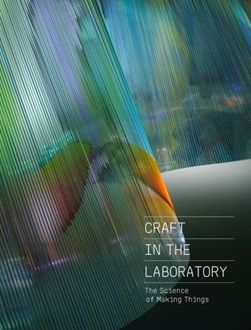-
BROWSE 1000s OF BOOKS IN STOCK
-
FREE DELIVERY ON ORDERS OVER €10
Craft in the laboratory
Hardback
Categories:
Exhibition catalogues and specific collections
This volume is the first to examine how craft artists and designers apply scientific and mathematical concepts to creating their work, and reveals approaches to problem-solving among these makers and professionals in STEM fields (science, technology, engineering and mathematics). The acronym STEM reflects educators' recognition that these fields are central to understanding how the 21st-century world functions, but those with training in the arts argue instead for the acronym STEAM, emphasizing how "art" intersects with the four other fields. Craft in the Laboratory builds off STEAM-related programming created by the Mint Museum of Art's department of Learning & Engagement to explore this intersection in depth. Drawn from the Museum's renowned permanent collection of craft and design in all media-ceramic, pottery, wood, metal, glass, fibre, textiles and design- this volume highlights how artists have thought like scientists and engineers. For example, Kate Malone's knowledge of the chemistry of clay bodies and glazes allows her to produce sculptures such as Heart Walnut . Douglas Harling made Vishnu Dreams using the ancient technique of granulation, aided by his understanding of the roles of surface tension, oxygen reduction, and eutectic bonds in fusing gold granules to a surface. Zoltán Bohus carefully planned the layers of glass in Stratofera on paper before creating it, using his knowledge of geometry and the prismatic qualities of glass. Technical aspects of materials and processes are discussed.
€43.50

130 Reward Points
In stock online
Extended Range: Delivery in 2-3 working days
Extended Range: Delivery in 2-3 working days
Free Delivery on this item
Any purchases for more than €10 are eligible for free delivery anywhere in the UK or Ireland!
This volume is the first to examine how craft artists and designers apply scientific and mathematical concepts to creating their work, and reveals approaches to problem-solving among these makers and professionals in STEM fields (science, technology, engineering and mathematics). The acronym STEM reflects educators' recognition that these fields are central to understanding how the 21st-century world functions, but those with training in the arts argue instead for the acronym STEAM, emphasizing how "art" intersects with the four other fields. Craft in the Laboratory builds off STEAM-related programming created by the Mint Museum of Art's department of Learning & Engagement to explore this intersection in depth. Drawn from the Museum's renowned permanent collection of craft and design in all media-ceramic, pottery, wood, metal, glass, fibre, textiles and design- this volume highlights how artists have thought like scientists and engineers. For example, Kate Malone's knowledge of the chemistry of clay bodies and glazes allows her to produce sculptures such as Heart Walnut . Douglas Harling made Vishnu Dreams using the ancient technique of granulation, aided by his understanding of the roles of surface tension, oxygen reduction, and eutectic bonds in fusing gold granules to a surface. Zoltán Bohus carefully planned the layers of glass in Stratofera on paper before creating it, using his knowledge of geometry and the prismatic qualities of glass. Technical aspects of materials and processes are discussed.

130 Reward Points
Any purchases for more than €10 are eligible for free delivery anywhere in the UK or Ireland!
€43.50

130 Reward Points
Any purchases for more than €10 are eligible for free delivery anywhere in the UK or Ireland!
Categories:
Exhibition catalogues and specific collections
Product Description
This volume is the first to examine how craft artists and designers apply scientific and mathematical concepts to creating their work, and reveals approaches to problem-solving among these makers and professionals in STEM fields (science, technology, engineering and mathematics). The acronym STEM reflects educators' recognition that these fields are central to understanding how the 21st-century world functions, but those with training in the arts argue instead for the acronym STEAM, emphasizing how "art" intersects with the four other fields. Craft in the Laboratory builds off STEAM-related programming created by the Mint Museum of Art's department of Learning & Engagement to explore this intersection in depth. Drawn from the Museum's renowned permanent collection of craft and design in all media-ceramic, pottery, wood, metal, glass, fibre, textiles and design- this volume highlights how artists have thought like scientists and engineers. For example, Kate Malone's knowledge of the chemistry of clay bodies and glazes allows her to produce sculptures such as Heart Walnut . Douglas Harling made Vishnu Dreams using the ancient technique of granulation, aided by his understanding of the roles of surface tension, oxygen reduction, and eutectic bonds in fusing gold granules to a surface. Zoltán Bohus carefully planned the layers of glass in Stratofera on paper before creating it, using his knowledge of geometry and the prismatic qualities of glass. Technical aspects of materials and processes are discussed.
Product Details
ISBN9781911282723
FormatHardback
PublisherGILES (01 February. 2022)
No. of Pages96
Weight776
Language English
Dimensions 292 x 222 x 16

